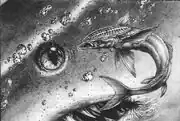Remora

Remora is the Background for the Rokea, the odd little messengers for the sharkfolk, soon learn which Rokea are polite to them.
Overview
They naturally tend to gravitate to these weresharks to give them a "first look" at what news they have found.
Millions of years ago, the remora were just normal little fish that swam around in schools like all the rest. But they had one very special quality to them: they remembered everything. If they saw a shark or an eel lurking around the mouth of a cave, they'd never enter that cave. If they got caught in a storm one year, they'd remember when, so that next year they could avoid it. They had one little problem, though. They were weak and slow, and their incredible memory did no good against a predator they couldn't avoid.
Well, Qyrl, as you might have heard, had her own races of flunkies beneath the waves. Some of them were leviathans bigger than cities, while some were shapechangers like us. In particular, there was one race of Changers that made her very proud. There was a time when anemones were not rooted to one spot the way they are now. Instead, they had a snail-like foot under them, and they oozed across the ocean floor. They were also much bigger than they are now, and their arms were strong enough to hold and poison a Rokea, if we got that close. These creatures — called the Qyrall, after their mother — used sand and their own ooze to build up fortresses underwater, using knowledge that Qyrl stole from C'et. They would ride the leviathans and use Qyrl's Gifts of stealth to block out the massive brutes' presence until they were right on top of a slew, then change into an almost-humanoid shape to do battle.
When the Rokea lose the battle, Leaps-to-the-Wound and the Remora make a deal: the Remora would ride on larger creatures — sharks, whales, and even leviathans — and would remember all they saw. They would use the Sending to foil the Qyrall's powers of invisibility, and that would give slews of Rokea time to prepare.
References
- WTA: Rokea, p. 44, 45, 63


- WTA/cMET: Laws of the Wild: Changing Breeds 4, p. 115-116, 179